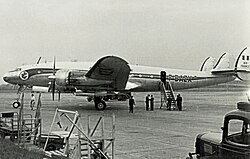 A Lockheed Constellation of Air France similar to the accident aircraft | |
| Accident | |
|---|---|
| Date | 28 October 1949 |
| Summary | Controlled flight into terrain due to pilot error |
| Site | Pico da Vara, São Miguel Island, Azores |
| Aircraft | |
| Aircraft type | Lockheed L-749-79-46 Constellation |
| Operator | Air France |
| Registration | F-BAZN |
| Flight origin | Paris-Orly Airport, France |
| Stopover | Santa Maria Airport, Azores, Portugal |
| Destination | New York City, United States |
| Occupants | 48 |
| Passengers | 37 |
| Crew | 11 |
| Fatalities | 48 |
| Survivors | 0 |
Air France Flight 009 was a scheduled international flight that crashed into a mountain while attempting to land at Santa Maria Airport, Azores, on 28 October 1949, on a stopover during a scheduled international passenger flight from Paris-Orly Airport to New York City. All 48 people on board were killed.